China, the Xinjiang issue and the Islamic State
It is known that in recent decades, China has been increasing its presence in many regions of the world. If before China actively positioned itself in the Asia-Pacific region, primarily in South and Southeast Asia, Oceania, and also in Central Asia, then later, Africa and Latin America were involved in the orbit of China’s interests. Naturally, China has its own interests in the Middle East, including Syria. China planned the development of the strategic project “The Great Silk Road”, which was supposed to pass, including in part of the Syrian territory. However, the civil war in Syria has confused China’s plans to develop the Silk Road. Therefore, the PRC is completely unprofitable, by and large, destabilization of the political situation in Syria and such scenarios as the disintegration of the state with the transformation of its former territory into a zone of “perpetual war of all against all”, or the victory of religious extremists with the construction of an absolutely unpredictable and non-contact totalitarian state. On the other hand, China fears the penetration of religious extremists in the Middle East into its own territory - through the same Afghanistan or the former Soviet republics of Central Asia. Despite its political, military and economic power, China is a country with considerable conflict potential, caused, among other things, by the peculiarities of the ethnic and religious situation in the country.
Ethno-confessional problems in Western China
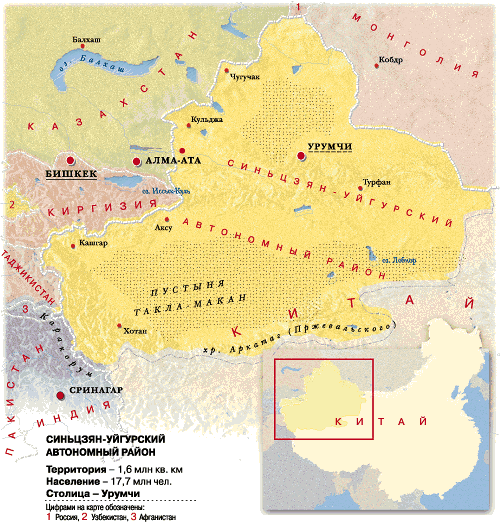 As you know, China includes a vast territory known as historical East Turkestan region. In this territory, which is part of the Xinjiang Uygur Autonomous Region of the People’s Republic of China (XUAR), a number of Turkic-speaking and Iranian-speaking peoples and ethnic groups professing Islam live. The largest among them are the Uyghurs, a ten million people who profess Sunni Islam. Linguistically, the Uyghurs are a Turkic-speaking people, close to neighboring Uzbeks and speaking the Uighur language of the Karluk branch of the Turkic languages. Until the 1933th century the Uyghur state maintained independence until it was captured by the Qing empire. However, even then, the central government of China loosely controlled the internal regions of East Turkestan, which in fact lived by their own laws. The Uyghurs regularly raised anti-Chinese uprisings, and in the twentieth century. twice there have been attempts to create independent Uyghur states - the Islamic Republic of East Turkestan in 1934-1944. and the East Turkestan Revolutionary Republic in 1949-1949. After the final inclusion in the PRC in 1910, the Xinjiang Uygur Autonomous Region was created. Uyghur nationalists claim that their people throughout history have been discriminated against by the Chinese, and in modern China, discrimination has taken on the character of restricting the birth of the Uyghurs, the Chinese settling the Uyghur territories by the Chinese, and oppressing the Uyghurs in various spheres of life. In addition to the Uyghurs, in the Xinjiang Uyghur Autonomous Region of China there are several more “Turkestan” peoples who are under the Uyghur cultural and political influence and also constitute a rather conflictogenic part of the Chinese population. Firstly, these are the Turkic peoples of Central Asia - Kazakhs, Kyrgyz, Tatars, Salars and Uzbeks, as well as Dunsyans - a small Mongol-speaking nation. For the most part, with the exception of a small part of the Kirghiz Buddhists, they profess Sunni Islam, however (except for Uzbeks and Salars) religion plays a lesser role in their life than in the life of Uyghurs. Secondly, these are the Pamir peoples - the Sarykol and Vakhans, who are considered Tajiks in China. They profess Shiism of Ismaili persuasion and are more independent of Uyghur cultural influence. The third group is Hui, or Dungans, Chinese Muslims who speak Chinese, but have long practiced Islam, which predetermined their cultural specifics and particular historical and political development. However, the Hui are more loyal to the central Chinese government than the Uyghurs. That is why Hui always played the role of “intermediaries” between the Chinese administration and Muslims of East Turkestan, although they themselves often acted as instigators of mass anti-government protests, especially during the existence of the Qing Empire and the first stage of the existence of Chinese republican statehood (1930-XNUMXs .).
As you know, China includes a vast territory known as historical East Turkestan region. In this territory, which is part of the Xinjiang Uygur Autonomous Region of the People’s Republic of China (XUAR), a number of Turkic-speaking and Iranian-speaking peoples and ethnic groups professing Islam live. The largest among them are the Uyghurs, a ten million people who profess Sunni Islam. Linguistically, the Uyghurs are a Turkic-speaking people, close to neighboring Uzbeks and speaking the Uighur language of the Karluk branch of the Turkic languages. Until the 1933th century the Uyghur state maintained independence until it was captured by the Qing empire. However, even then, the central government of China loosely controlled the internal regions of East Turkestan, which in fact lived by their own laws. The Uyghurs regularly raised anti-Chinese uprisings, and in the twentieth century. twice there have been attempts to create independent Uyghur states - the Islamic Republic of East Turkestan in 1934-1944. and the East Turkestan Revolutionary Republic in 1949-1949. After the final inclusion in the PRC in 1910, the Xinjiang Uygur Autonomous Region was created. Uyghur nationalists claim that their people throughout history have been discriminated against by the Chinese, and in modern China, discrimination has taken on the character of restricting the birth of the Uyghurs, the Chinese settling the Uyghur territories by the Chinese, and oppressing the Uyghurs in various spheres of life. In addition to the Uyghurs, in the Xinjiang Uyghur Autonomous Region of China there are several more “Turkestan” peoples who are under the Uyghur cultural and political influence and also constitute a rather conflictogenic part of the Chinese population. Firstly, these are the Turkic peoples of Central Asia - Kazakhs, Kyrgyz, Tatars, Salars and Uzbeks, as well as Dunsyans - a small Mongol-speaking nation. For the most part, with the exception of a small part of the Kirghiz Buddhists, they profess Sunni Islam, however (except for Uzbeks and Salars) religion plays a lesser role in their life than in the life of Uyghurs. Secondly, these are the Pamir peoples - the Sarykol and Vakhans, who are considered Tajiks in China. They profess Shiism of Ismaili persuasion and are more independent of Uyghur cultural influence. The third group is Hui, or Dungans, Chinese Muslims who speak Chinese, but have long practiced Islam, which predetermined their cultural specifics and particular historical and political development. However, the Hui are more loyal to the central Chinese government than the Uyghurs. That is why Hui always played the role of “intermediaries” between the Chinese administration and Muslims of East Turkestan, although they themselves often acted as instigators of mass anti-government protests, especially during the existence of the Qing Empire and the first stage of the existence of Chinese republican statehood (1930-XNUMXs .). The extent of the spread of Islam in China until recently underestimated, but according to a sociological survey conducted in 2015, over 22% of Chinese under the age of 30 are Muslims. That is, almost every fourth young citizen of China is a Muslim. This is explained, among other things, by the peculiarities of the national and demographic policy of the PRC. The fact is that for a long time Chinese families were not allowed to have more than one child, while families of national minorities, including the Muslim peoples of Eastern Turkestan, had privileges - they were allowed to have more than one child. As a result, a situation arose when the actual Chinese (Buddhist-Taoist-Confucian) population of the country began to grow old, and national minorities started to grow younger. For example, among Chinese older than 60, at least half of the years are practicing traditional creeds of the country - Taoism and Confucianism. However, despite the fact that Muslims among the Chinese youth are noticeably more than among the older generations, in general, Chinese Islam is not yet characterized by a high scale of radicalization. But this - if we talk about Chinese Muslims - Hui. As for the Uighurs, the situation there is somewhat different. The fact is that the Uigurs truly represent a nation that is fundamentally different from the Chinese and has its own rich history, cultural traditions, written language, and finally - religion, which is one of the pillars of national identity. The Uighurs' struggle for national liberation has continued since the lands inhabited by the Uigurs fell into the orbit of the political interests of the Chinese empire and were attacked by Chinese troops.
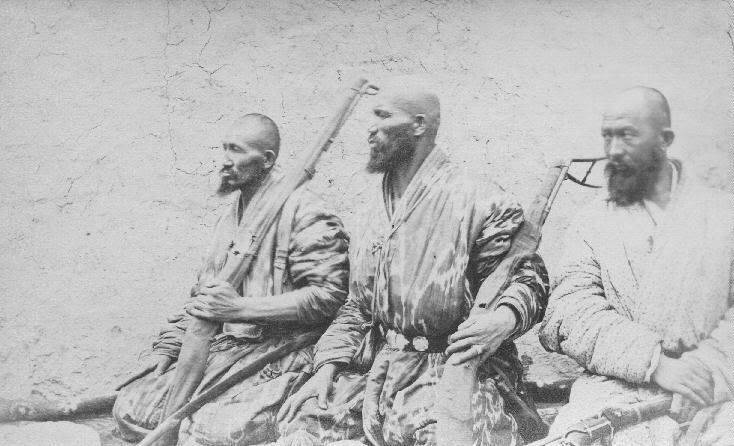
Ancient people without a state
The Uigurs are an ancient people whose name has been known since the beginning of our era. In the IX century. AD Turkic Uygur tribes migrated to the territory of East Turkestan, where the further development of Uygur culture and statehood took place. The Iranian-speaking ethnic groups living on the territory of East Turkestan were assimilated by the Uighurs and joined the Uighur tribes. For a long time, the territory of East Turkestan was a region of unique confessional pluralism — traditional for Turkic peoples, Shamanism, Manichaeism, Buddhism, and Nestorian Christianity were spread among the local population (the Nestorians were active in preaching in Central Asia and China). In the X century. in the largest oasis cities of Eastern Turkestan — Yarkende, Kashgar and Khotan — Islam began to spread through the efforts of Arab-Persian merchants. However, the process of Islamization of the Turkic population of Eastern Turkestan stretched out for several centuries and only by the 16th century. Islam practically supplanted all other religions that had previously been professed by the people of the region. In the process of Islamization of the Uigurs, the Uighur writing was supplanted by Arabic writing, borrowed from Arabic and Persian languages into the Uigur language, began to strengthen cultural cooperation not only with neighboring Central Asia - Western Turkestan, but also with Persia, the Arab East, Northern India. At the same time, the ethnonym Uigur itself in Central Asia of the XV-XVII centuries. It was not widely used because it was widely used to identify the local Turkic Muslim population with the terms “Muslim” or “Turks”, or with narrower regional or tribal names - “Kashgarets”, “Hotanets”, etc. (these are the names of the “yurts” - sub-ethnic groups of the Uyghur people). Gradually, tribes of Mongolian origin, who wandered here, gradually mixed with the Turkic population, joined the Uygur community of Eastern Turkestan.
After the territory of East Turkestan began to be gradually seized by the Qing Empire, the era of severe tests began in the history of the Uyghur people, including, in particular, attempts to fight for the preservation of national statehood. However, the Uighurs could not fully resist the much stronger Qing Empire. Xinjiang Province was established on the territory of East Turkestan, and its intensive settlement with Manchus and Chinese began. Thus, in Xinjiang, garrisons recruited from the Solon and Daur of Manchuria were placed in 1764. Several thousand Siboes were resettled in the Yili valley, representatives of the Manchurian-speaking people who lived in northeastern China, in the modern provinces of Liaoning and Jilin, which on the border with the DPRK. Nevertheless, uprisings were repeatedly raised and de facto independent Uygur states were created on the territory of East Turkestan. These included, in particular: the Kucharsky Khanate, created in 1864 as a result of an uprising in the territory of Turfan, Hami, Aksu and Usha; Dungan Khanate (later - Urumqi Sultanate), which appeared in the same year in Urumqi; Khotan Khanate, created by Mullah Habibullah; Kashgar Khanate, in the same 1864, created by Buzruk-Khoja. The Uigur movement wore anti-Manchu and anti-Chinese character, uniting all the Muslim peoples of Eastern Turkestan - Uygur, Dungan, Kazakhs, Kyrgyz, Tatar, Uzbeks, Salars, Pamirs, Tajiks. However, in 1875, the troops of the Qing Empire were moved to East Turkestan, which were previously tasked to achieve the conquest of Dzungaria. By December 1877, the Manchu troops managed to restore the power of the Qing Empire almost over the whole territory of Xinjiang, except for the Ili region. Last in 1871-1881. was part of the Turkestan Military District of the Russian Empire, and in 1881, in accordance with the Petersburg Treaty, was transferred back to the Qing Empire for compensation of expenses related to the ten-year Russian administration of this territory.
By the beginning of the twentieth century. In East Turkestan, ideas of the region’s political independence began to spread, acquiring more modern outlines. Thus, Jadidism and Pan-Turkism spread, penetrating into the region from Russian Turkestan and from Turkey. As is known, the Jadids advocated the modernization of Islam, called for the use of national languages in teaching children and replacing religious schools with secular ones in which modern knowledge would be taught. The spread of Jadidism in Eastern Turkestan played an important role in the formation of the Uyghur national liberation movement. But even more influenced by the revolutionary events in Russia. First, a stream of Turkic migrants from the Soviet Union, primarily from Central Asia, poured into East Turkestan. Many immigrants were politically literate people and advocated the creation and strengthening of the Turkic nationalist movement, using, moreover, the support of Western powers interested in weakening the positions of the USSR in Central Asia. Secondly, on the other hand, the creation of national republics in neighboring Central Asia allowed the Uygurs to gain hope for possible political independence or, at least, autonomy from China, taking into account the example of their neighbors - co-religionists and brothers in Turkic blood. Meanwhile, in Xinjiang, Governor Jin Shujen came to power, who began a policy of violent Sinization of the Turkestan population, banning Islamic events and replacing Uighur and Dungan officials with Han Chinese and representatives of other non-Muslim Chinese groups. Naturally, this activity of Shuzhen caused an increase in discontent among the Muslim population of East Turkestan. Against the policies of Shuzhen, rebellions of the local Muslim population repeatedly flared up. So, 16 March, March 1933 was an independent Khotan Emirate, led by the Bukhra brothers, was proclaimed as a result of an uprising of workers at gold mining near the town of Keriya. The rebels destroyed the officials of the Chinese administration, defeated the garrisons and forced the peaceful Chinese population to convert to Islam.
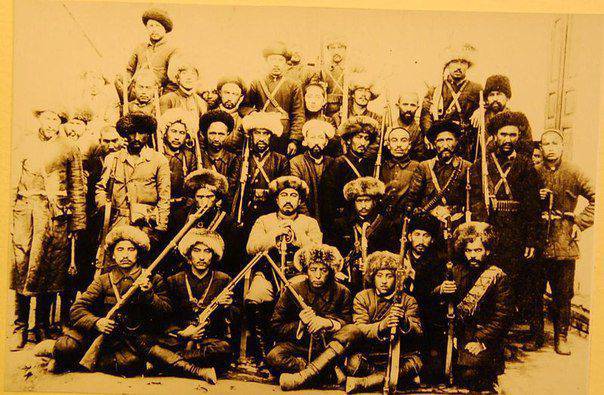
In September 1933, the creation of the East Turkestan Republic was announced, and on November 12, the creation of the Turkic Islamic Republic of East Turkestan (TIRST), also known as the Uyguristan Republic. Khotan Emirate and TIRST acted independently of each other, while TIRST controlled the territory from Aksu to Khotan. The authorities in TIRST were supporters of Jadidism, who supported the political and economic modernization of Uygur society and the transformation of East Turkestan into a modern country independent of China. But plans to create such a state have failed. First, none of the neighboring countries agreed to provide support to the self-proclaimed republic. The Soviet Union refused to cooperate with the Turkic nationalists and Islamists. The authorities of British India also did not want to spoil relations with the Soviet Union and China and support the separatist movement. Even Iran, Afghanistan and Turkey refused to help the Uygur separatists. TIRST had certain hopes of support from Germany and Italy, but ultimately Hitler’s Germany preferred to cooperate with China than to provide support to dubious and small separatists. Soviet brigades — the Altai and Tarbagatai — whose soldiers, to disguise and withdraw from the Soviet Union in support of one of the sides of the confrontation in Xinjiang, dressed in the form of the white Cossacks, were even attached to the Chinese troops of Sheng Shitsai, who were sent to pacify the Huizu revolt. The participation of Soviet troops in the suppression of the Uighur uprising was associated with Moscow’s fears of a possible spread of the Turkic nationalist movement to the territory of the Soviet Central Asian republics, where they only managed to cope with their own Basmaan movement and with the possible use of Xinjiang separatists by Japan, which actively used the practice of building on Chinese territory national minority states. Thus, with the support of Japan, Manchukuo in Northeast China and Mengjiang in Inner Mongolia were created. The troops of the Kuomintang and the Dungan general Ma Zhantsana attacked TIRST and inflicted a crushing defeat on the independence supporters of Eastern Turkestan, cutting out a large part of its defenders. The President of the Republic, Khoja Niyaz, escaped on the territory of the Soviet Union, other prominent leaders of the uprising fled to Afghanistan and India.
The repeated attempt to gain state independence by the residents of Eastern Turkestan took place in 1944-1945, when the East-Turkestan Revolutionary Republic was established in the Ili, Altai and Tachen districts of Xinjiang Province. As a result of the uprising against the Kuomintang troops, 12 in November 1944 the independence of the East Turkestan Republic was proclaimed, which was positioned as a democratic state of all the peoples inhabiting Xinjiang. It is significant that the government headed by the head of the Muslims of the Ili district, ethnic Uzbek Alikhan-Ture (pictured), included not only Uighurs and Uzbeks, but also Tatars, Kazakhs, Kalmyks and even Russians IG. Polinov and F.I. Leskin. After the defeat of the KMT, 19 September 1949 Burgan Shahidi, who headed the government of Xinjiang and, by the way, appointed to this position by Chiang Kai-shek, went over to Mao Zedong and announced the entry of East Turkestan into the PRC. The armed forces of East Turkestan were incorporated into the People’s Liberation Army of China. However, despite the fact that Xinjiang received formal autonomy within the Chinese People’s Republic, the situation of the Uyghur population in the country has not improved at all.
Religious radicalism and separatism in Xinjiang
 A serious blow to the Uighurs and other Muslim peoples of Turkestan was dealt with during the years of the “cultural revolution”, which was characterized by a powerful onslaught on religion. Separatist sentiments spread in the region, which intensified after the collapse of the Soviet Union and the emergence of the independent Turkic republics of “Western Turkestan” - Kazakhstan, Kyrgyzstan, Uzbekistan, and Turkmenistan. Naturally, this had an encouraging influence on the Uyghur national movement. On the other hand, the radicalization of the Uyghur Muslim community, including the penetration of radical ideas from Afghanistan and Pakistan, has become an important source of the growth of separatist sentiments in Xinjiang. The fact is that in the middle of the twentieth century, after Xinjiang joined the People’s Republic of China, a significant part of the Uigurs, who did not want to submit to the Chinese Communist government, emigrated to neighboring Afghanistan and Pakistan, a very large Uyghur diaspora was formed in Turkey. In emigration, the process of creating religious-fundamentalist and nationalist organizations advocating the independence of East Turkestan began. Later, some Uighurs took part in the hostilities in Afghanistan - on the side of the Taliban and in Pakistan - on the side of Waziristan.
A serious blow to the Uighurs and other Muslim peoples of Turkestan was dealt with during the years of the “cultural revolution”, which was characterized by a powerful onslaught on religion. Separatist sentiments spread in the region, which intensified after the collapse of the Soviet Union and the emergence of the independent Turkic republics of “Western Turkestan” - Kazakhstan, Kyrgyzstan, Uzbekistan, and Turkmenistan. Naturally, this had an encouraging influence on the Uyghur national movement. On the other hand, the radicalization of the Uyghur Muslim community, including the penetration of radical ideas from Afghanistan and Pakistan, has become an important source of the growth of separatist sentiments in Xinjiang. The fact is that in the middle of the twentieth century, after Xinjiang joined the People’s Republic of China, a significant part of the Uigurs, who did not want to submit to the Chinese Communist government, emigrated to neighboring Afghanistan and Pakistan, a very large Uyghur diaspora was formed in Turkey. In emigration, the process of creating religious-fundamentalist and nationalist organizations advocating the independence of East Turkestan began. Later, some Uighurs took part in the hostilities in Afghanistan - on the side of the Taliban and in Pakistan - on the side of Waziristan. Back in 1993, the Eastern Turkestan Islamic Movement (IDTB) was created, advocating the creation of a Sharia Islamic state in East Turkestan and the conversion of the entire population of the region to Islam. The organization was founded by Hasan Maksum, who is also Abu-Muhammad al-Turkestani (1964-2003) - a native of Kashgar and a professional fighter who joined the armed organization that opposed the Chinese authorities in Xinjiang at the age of twenty. Subsequently, Maksum was granted asylum in Afghanistan, and the Taliban issued him an Afghan passport. After pushing the Taliban back to Pakistan, he moved to where he died in 2003. Establishing Uighur radicals with the Afghan Taliban and Al Qaeda led to the gradual spread of Salafism among the younger part of the radical supporters of Uyghur independence and the creation of East Turkestan Islamic Sharia state.
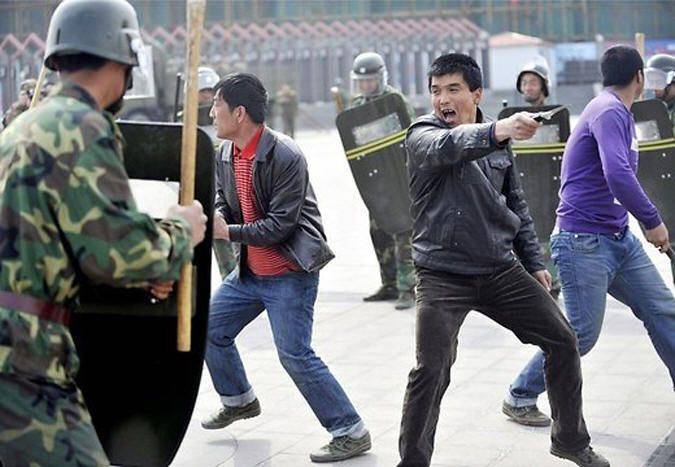
In 1997, the ETIM was reorganized, after which the movement began active armed operations in Xinjiang, receiving financial and military assistance from the Afghan Taliban and international terrorist organizations such as Al-Qaeda, banned in Russia. After the death of Hassan Maksum, the organization was actually headed by Abdul Shakur al-Turkestani, who died only in 2012 - also in Pakistan, as a result of an attack by an American drone. ETIM militants managed to carry out a whole series of terrorist attacks on the territory of the PRC. Among them are the explosion of a warehouse in Urumqi on May 23, 1998; hostages in Gum on December 25, 1999, an attack in Kashgar on February 19, 2010. Also, militants of the East Turkestan Islamic Movement take part in the civil war in Afghanistan and the armed resistance of Waziristan in the Tribal Zone in Pakistan. In China, as well as the United States, Kazakhstan, Kyrgyzstan and a number of other states, the East Turkestan Islamic Movement is recognized as a terrorist organization. By the way, in the PRC, a much more moderate political organization of the Uyghur people, the World Uyghur Congress, headed by the well-known Uyghur human rights activist Rabiya Kadeer, is also considered terrorists. According to the Chinese leadership, this organization may be behind the organization of mass riots in Urumqi in 18. Then, as a result of the clashes that occurred on July 2011, 30, 31 people died, about 2011 people were injured and injured of varying severity. The reason for the unrest was the revenge of Uyghur activists for the events in the Chinese province of Guangdong, where as a result of a domestic quarrel, a mass brawl broke out between Chinese and Uyghur workers, during which two Uyghurs were killed. In response, Uyghur radicals staged a "Chinese pogrom" in Urumqi, but the unrest was suppressed by the police and paramilitary police. Thirty of the detained rioters were sentenced to the capital punishment of the PRC - the death penalty.
Bloody attacks - the work of extremists
1mart 2014, eight people in masks and black clothes, armed with machetes and long knives, burst into the waiting room of the Kunming Railway Station - the capital of the southern Chinese province of Yunnan. They staged a massacre in the station building, having managed to kill and injure an 29 man by the time the police arrived and kill the 143 man. Policemen shot four criminals at the scene, wounded another woman terrorist, and three terrorists who managed to escape from the station building were caught several days later. The Chinese media dubbed the attack as “our eleventh of September”, drawing attention to the large number of human victims, and to the cruelty and ruthlessness of the terrorists who acted in a brutal way. Two days after the terrorist attack, the Chinese authorities reported identifying the identities of the terrorists - they, according to the Chinese police, were immigrants from the Xinjiang Uygur Autonomous Region. Chinese law enforcement agencies say that in recent years, violent acts of terrorism committed by fighters for the independence of East Turkistan have become more frequent. At the same time, the trend of terrorists is going beyond the Xinjiang Uygur Autonomous Region - obviously, the terrorists are trying to show the Chinese people that the problem of East Turkestan is not local, but national in nature and can be affected by their actions in any part of China. However, the actions of the Uyghur radicals also provoke a backlash from the Chinese against any representatives of the Uyghur, as well as other Turkic and Muslim peoples of China. In particular, in the eastern provinces of China, there are attacks by local people on Uigur workers and students, the Uygurs prefer not to provide jobs and not to rent apartments and other premises. The Chinese government, in turn, tightened the police regime in the Xinjiang Uygur Autonomous Region.
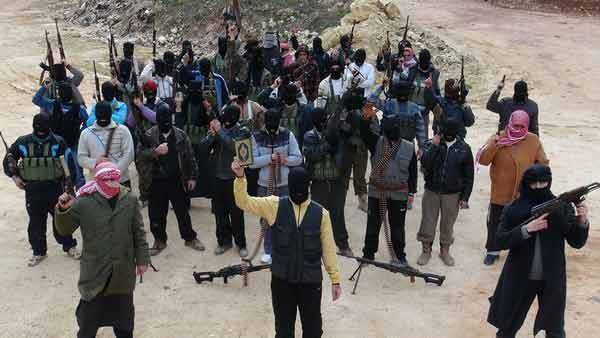
Despite the police activities, terrorist attacks in the territory of the PRC are continuing. In October 2013, extremists committed a terrorist act in the very center of Chinese statehood - on the famous Tiananmen Square in Beijing. Three "suicide bombers" in a jeep with numbers of the Xinjiang Uygur Autonomous Region crashed into a group of tourists who were walking at the gates of the Forbidden City on the square. After the jeep hit people, it caught fire and exploded. As a result, the terrorists themselves and two passersby died. About forty more people were injured. 18 people died on 22 on June 2015 during an attack by extremists on a police checkpoint in the city of Kashgar, Xinjiang Uygur Autonomous Region (XUAR). The Chinese authorities are seriously concerned about the issues of the country's internal security and are allocating considerable forces and means to antiterrorist activities. First of all, law enforcement agencies and security forces in the Xinjiang Uygur Autonomous Region are being strengthened, on the territory of which, given the presence of numerous hard-to-reach places, including in the mountains, there may be bases of militants leaking from the territory of Afghanistan and Pakistan. At the same time, the Chinese leadership has recently been actively avoiding informing the population about the national identity of the terrorists, paying attention only to the fact that they are from Xinjiang. This is done, first of all, to prevent the "pogroms" of the Uyghur communities in the cities of other provinces of the People's Republic of China, as well as to appease the Uighurs themselves, who should not feel second-class citizens and, accordingly, join the ranks of radical organizations. However, the activization of extremists in China depends on international factors, which include both the stimulation of their activities by international structures interested in destabilizing the political situation in China, and the overall intensification of the armed struggle of religious fundamentalists in the Middle East, North and West Africa in Central Asia.
Radicals from Xinjiang and the "Islamic State"
The emergence in the Middle East of a new active force in the face of the "Islamic state" (a terrorist organization banned in the Russian Federation) creates certain risks for China. Firstly, it is widely known that the IG has recently intensified its activities in Afghanistan, where it is beginning to gradually turn into a rival of the Taliban. Accordingly, certain positions of the IG have in neighboring Pakistan. Naturally, East Turkestan-Xinjiang, which is in close proximity to Afghanistan and Pakistan, is also of interest to the Islamic State, especially given that the XUAR’s Muslim population is dissatisfied with its position, and the youth are ready to take radical steps to change their position and possible creation of an independent Muslim state. Secondly, many Uygurs took and take part in hostilities in Iraq and Syria, fighting on the side of the "Islamic State". It is known that interested Turkish organizations, which have long-standing and well-developed ties with the Uyghur national movement, play a certain role in transporting the Uyghur militants to Syria. The unemployed Uyghur youth, especially those associated with the nationalist movement and not having the opportunity, because of their unreliability, to find work in the XUAR, are sent from China to work in countries where there is a need for working hands. Many of them come to Malaysia, Indonesia and some other countries of Southeast Asia. In the Malaysian capital, Kuala Lumpur, according to the Turkish newspaper Hurriyet, the Uygurs from the PRC receive Turkish certificates, with the help of which they have the opportunity to travel to Turkey, where Uigur militants are trained in training camps and their further transfer to Syria and Iraq.
It should be noted that the countries of Southeast Asia, not wanting to quarrel with China, prefer to hand over Chinese citizens of Uyghur nationality detained on their territory and suspected of involvement in the terrorist underground to the Chinese special services. So, in July 2015, the Thai government issued 109 Uighurs to China - and this despite the fact that protests against extradition were expressed by the USA - Thailand's main military-political ally in the Asia-Pacific region. Most of the deported Uigurs were illegal immigrants who went to Thailand to work on local rubber plantations. According to Thai media, at least 13 from the arrested Uigurs planned to travel to Syria and Iraq in the near future to take part in hostilities on the side of the Islamic State. After it became known about the deportation of Uighurs from Thailand to the PRC, a local Uygur radical youth attacked the Thai consulate in Istanbul in Turkey. After the hooligan action of the diaspora, Thailand has closed indefinitely the country's embassy in Ankara. It is known that the Turkish Uygurs are the most radical and have close ties with radical organizations, because at one time the core of Uyghur emigration to Turkey was composed of convinced nationalists - Pan-Turkists and Islamists, who did not see a future for themselves in communist China. In Indonesia, in September 2014, February and June 2015, groups of citizens of Uygur origin who carried out terrorist activities in Indonesia received long prison sentences. However, despite precautionary and preventive measures, some Chinese citizens still manage to penetrate Syria and Iraq. Thus, according to some data, the number of IS militants with Chinese citizenship, predominantly Uyghur by nationality, reaches at least 300 people. It is likely that there may be more, given the large number of the Uyghur population of the PRC and the bitterness of the radical part of the Uyghur youth over their position in the PRC. On the other hand, for the Chinese leadership, the secret departure of radical Uygurs to Syria and Iraq also has some benefit - at least, Beijing gains the hope that a significant part of the "power potential" of the Uygur radicals will be diverted to fighting in Syria and Iraq, and many radicals will never return to China, dying in hostilities with the Assad government forces, the Iraqi army or the Kurdish militia.
China is unlikely to provide direct military assistance to the Assad government or even the Russian Federation in the event of the further development of the antiterrorist operation in Syria. Given that China has its own accounts for religious radicals from the IG, one of whose constituent organizations is leading a terrorist war in the territory of Xinjiang Province, the Chinese leadership will not want to lose multi-billion contracts in case of deterioration in relations with Saudi Arabia. The trade between China and Saudi Arabia exceeds seventy billion dollars a year, that is, it is seventy times more than the Russian-Saudi trade. Accordingly, cooperation with Saudi Arabia is very significant for the Chinese economy, especially since we are talking about many projects that are under development and should be supplied with orders from Chinese companies and enterprises for many years to come. On the other hand, China’s economic ties with Iran are expanding, and the latter, as we know, is the main regional ally of the government of Bashar al-Assad in Syria. Therefore, it is likely that the PRC, without interfering in the Syrian conflict, will tack between the various opposing sides, in general, is more favorable to the position of the Russian Federation. As Vasily Kashin, an expert at the Center for the Analysis of Strategies and Technologies, said in an interview, considering the position of the Chinese political leadership on the issue of the Russian Federation’s military operation in Syria, “China is positive about our operation. At the political level, Beijing has expressed support for Moscow in the fight against terrorism. Comments of major Chinese media are also benevolent. But China is not yet ready to intervene in the Syrian conflict. True, the discussion on this topic is underway. Previously, such questions as “Shouldn't we intervene?” Or “Under what conditions should we get into this?”, In principle, did not arise ”(quoted on: http://lenta.ru/articles/2015/10 / 30 / kashinonsyria /).
On the other hand, we should expect further strengthening of the anti-terrorist activities of the Chinese special services and law enforcement agencies, primarily in the Xinjiang Uygur Autonomous Region, which will be associated with countering the possible infiltration of terrorists from the territory of Afghanistan and Pakistan into the Chinese territory, and possibly the former Soviet republics of Central Asia. For the Russian Federation in the current situation, the importance of cooperation with China in the field of ensuring antiterrorist security in the region of Central Asia, primarily in Afghanistan, Uzbekistan, Kyrgyzstan and Tajikistan, increases. China, as the largest power in the region, has its strategic interests in it, but at the moment they overlap with the interests of Russia - namely, to prevent the expansion of the influence of religious extremists on the territory of the Central Asian republics and, if possible, to prevent religious radicals from significantly strengthening their positions in Afghanistan. It is known that the PRC government closely cooperates with the authorities of Kazakhstan and Kyrgyzstan in terms of organizing joint prevention of terrorism and extremism. At the request of the Chinese intelligence services, citizens of the People's Republic of China from among the representatives of the Uygur radical organizations located in Kazakhstan and Kyrgyzstan are issued to China for the further implementation of investigative measures. In turn, the PRC provides assistance to the Kazakh and Kyrgyz leadership in countering the spread of religious radicalism in the republics.
- P P 'SЊSЏ RџRѕR "RѕRЅSЃRєRёR№
- http://tvorec.gorod.tomsk.ru/, http://maxpark.com/, http://www.anaga.ru/ , 3wwar.ru
Information